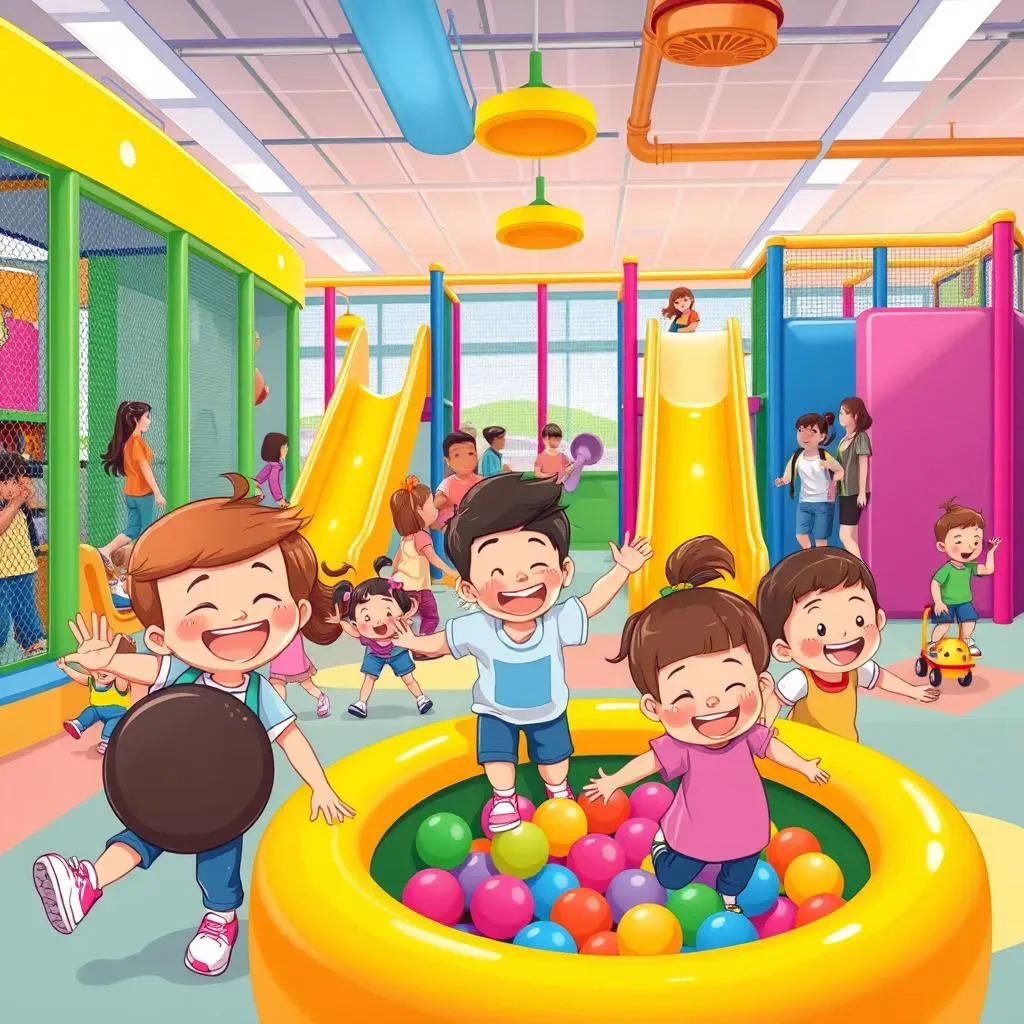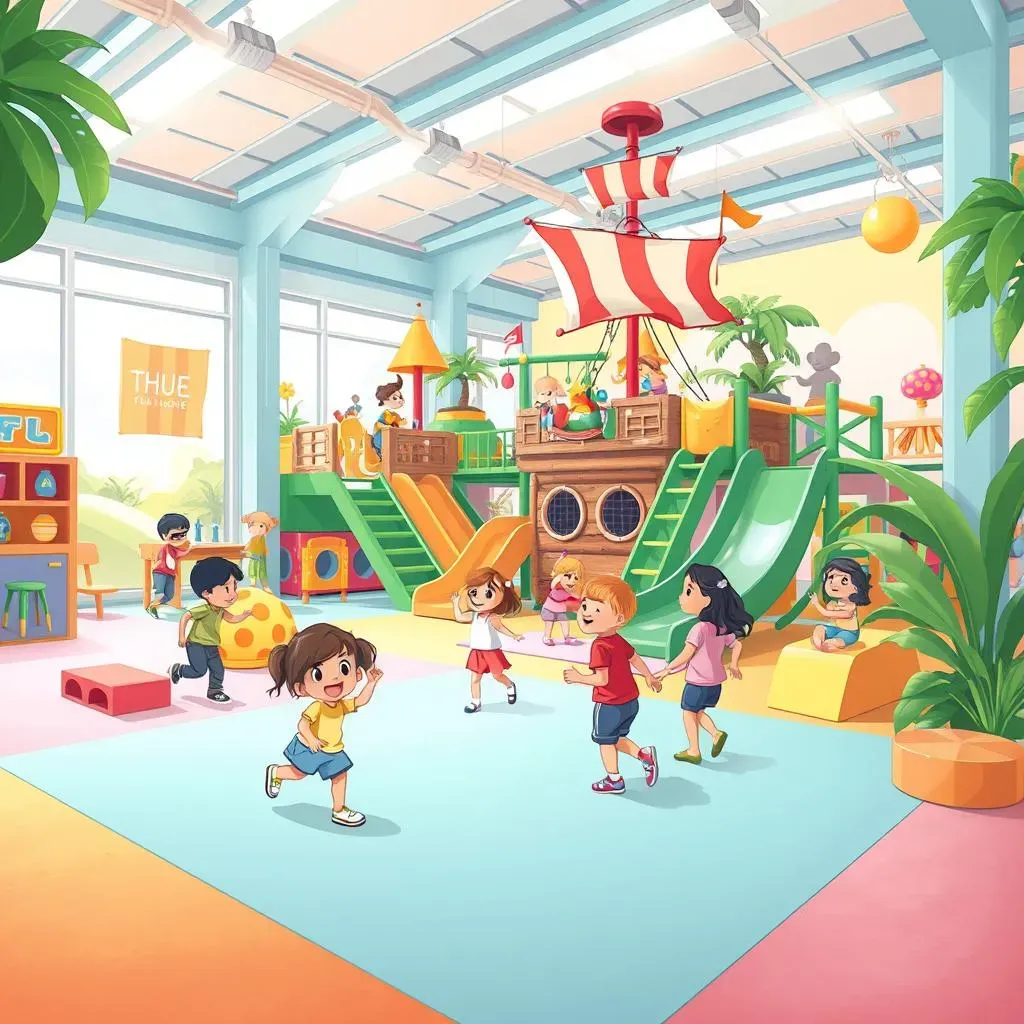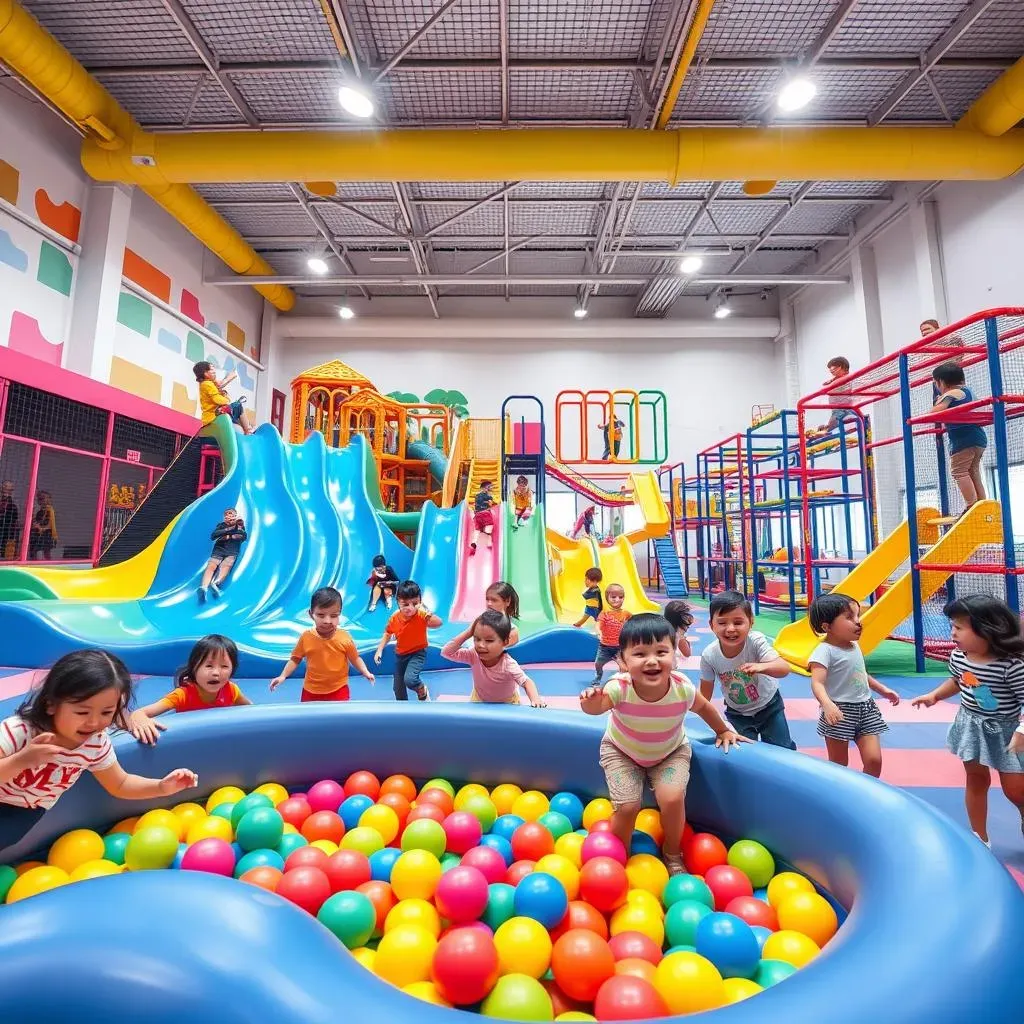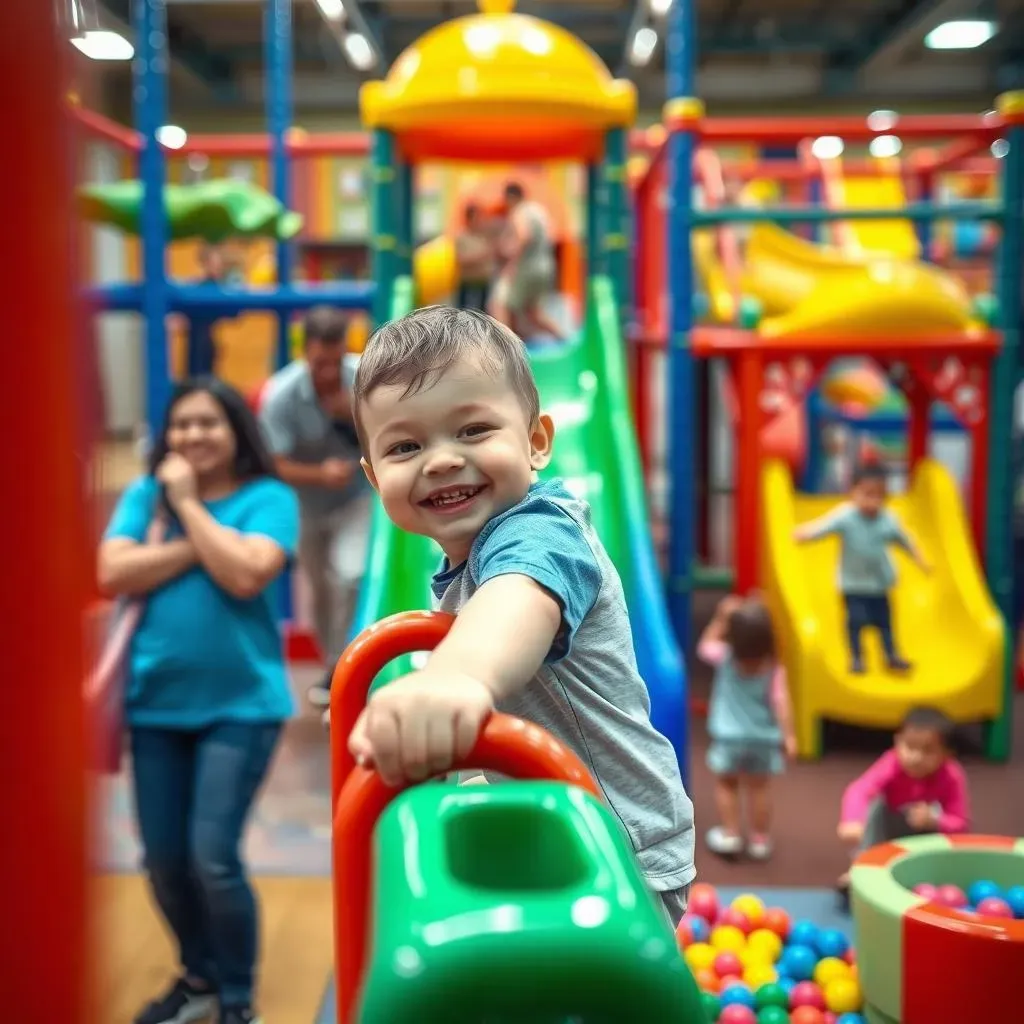Table of Contents
Looking to create a world of fun and adventure for kids, right in your own facility? You're likely exploring the exciting world of kids indoor playground equipment. From bustling family entertainment centers to cozy daycare corners, these play spaces are popping up everywhere, offering a safe and engaging environment for children to explore, learn, and burn off some energy, no matter the weather outside.
Why Invest in Kids Indoor Playground Equipment? Benefits & Considerations

Why Invest in Kids Indoor Playground Equipment? Benefits & Considerations
Unlocking the Potential: The Core Benefits of Indoor Play
Let's face it, keeping kids active and entertained can be a real challenge, especially when the weather isn't cooperating. That's where kids indoor playground equipment comes in as a total game-changer. Think about it: a dedicated space for kids to run, jump, climb, and explore, all within the safety and comfort of your facility. This translates to a significant boost in physical activity, helping combat sedentary lifestyles and promoting healthy development. But it's not just about burning energy; indoor playgrounds foster crucial social skills as children interact, cooperate, and learn to navigate group dynamics. Plus, the sheer fun factor keeps kids engaged and coming back for more, making it a win-win for everyone involved.
Beyond the obvious physical and social advantages, indoor playgrounds offer a unique opportunity for cognitive development. Many structures incorporate elements that encourage problem-solving, spatial reasoning, and imaginative play. Whether it's navigating a maze, building with oversized blocks, or creating stories within a themed play area, children are constantly learning and growing through play. And for businesses, this translates to increased customer satisfaction, longer dwell times, and a reputation as a family-friendly destination.
Making Informed Decisions: Key Considerations Before Investing
so you're sold on the idea of kids indoor playground equipment, but where do you start? Before you dive headfirst into purchasing, it's crucial to take a step back and carefully consider your specific needs and goals. What age range are you targeting? What's your budget? How much space do you have available? These are all vital questions that will help you narrow down your options and make the right investment. For example, a daycare center catering to toddlers will have very different requirements than a family entertainment center designed for older children.
Another critical consideration is safety. Ensure that any equipment you're considering meets or exceeds industry safety standards and is constructed from durable, non-toxic materials. Regular maintenance and inspections are also essential to keep your playground in top condition and minimize the risk of accidents. Finally, think about the overall design and theme of your play area. A well-designed playground should be visually appealing, stimulating, and encourage a variety of play activities. By carefully considering these factors, you can create an indoor playground that is not only fun and engaging but also safe, sustainable, and a valuable asset to your business or organization.
Checklist for Investing in Kids Indoor Playground Equipment
- Target age range
- Budget
- Available space
- Safety standards compliance
- Material durability and toxicity
- Maintenance requirements
- Design and theme
- Variety of play activities
Essential Features of Safe and Engaging Kids Indoor Playground Equipment

Essential Features of Safe and Engaging Kids Indoor Playground Equipment
Prioritizing Safety: Must-Have Features for Peace of Mind
When it comes to kids indoor playground equipment, safety isn't just a feature; it's the foundation upon which everything else is built. We're talking about creating a space where kids can freely explore and challenge themselves without parents or caregivers constantly worrying about accidents. So, what are the non-negotiable safety features you should be looking for? First and foremost, impact-absorbing surfaces are a must. Think thick padding, rubber flooring, or safety mats strategically placed beneath climbing structures and high-traffic areas. These surfaces can significantly reduce the risk of injuries from falls. Also, regular inspections of the equipment are vital.
Beyond surfacing, the construction of the playground itself needs to be top-notch. Look for sturdy materials, smooth edges, and secure connections. Any climbing structures should have appropriate handholds and footholds that are easy for children to grip. Enclosed areas, like tunnels or slides, should be well-ventilated and have clear visibility to prevent claustrophobia or hidden hazards. And don't forget about age-appropriateness! Equipment designed for toddlers should be separate from areas intended for older children to prevent accidental collisions or injuries. By prioritizing these safety features, you can create an indoor playground that is both fun and secure for all children.
Is the equipment certified?
Sparking Imagination: Designing for Engaging Play
A safe playground is essential, but an engaging playground is what keeps kids coming back for more. The key is to create a space that sparks imagination, encourages creativity, and offers a variety of play experiences. Think beyond basic slides and swings, and consider incorporating elements that stimulate different senses and challenge children's problem-solving skills. Themed play areas, for example, can transport kids to different worlds, whether it's a pirate ship, a jungle, or a castle. These immersive environments encourage imaginative play and storytelling, allowing children to create their own adventures.
Also, think about incorporating elements that encourage different types of play. Climbing structures promote physical activity and coordination, while building blocks and construction zones foster creativity and problem-solving skills. Interactive games and puzzles can challenge children's minds and encourage teamwork. The goal is to create a space that caters to a variety of interests and abilities, ensuring that every child can find something to enjoy. By focusing on engagement, you can create an indoor playground that is not only safe but also a stimulating and enriching experience for all children.
Types of Kids Indoor Playground Equipment: From Toddler Zones to Adventure Courses

Types of Kids Indoor Playground Equipment: From Toddler Zones to Adventure Courses
Toddler-Friendly Zones: Soft Play and Sensory Exploration
When we talk about kids indoor playground equipment for the littlest ones, it's all about creating a safe, soft, and stimulating environment. Think of it as a sensory wonderland! Soft play areas are the bread and butter here, featuring padded floors, gentle slopes, and squishy shapes that encourage crawling, climbing, and exploration without the risk of bumps and bruises. These zones often incorporate bright colors, textures, and sounds to engage a toddler's developing senses. Ball pits are a classic favorite, providing a tactile and visually stimulating experience, while soft blocks and puzzles encourage problem-solving and fine motor skills. The goal is to create a space where toddlers can freely explore and develop their physical and cognitive abilities in a safe and supportive environment.
Beyond the basic equipment, consider adding elements that promote imaginative play. Small tunnels, playhouses, and themed structures can spark a toddler's creativity and encourage them to create their own stories and adventures. Just remember to keep everything low to the ground and easily accessible for little legs and arms. And don't forget about adult supervision! A comfortable seating area nearby allows parents and caregivers to keep a close eye on their little ones while they play.
Classic Play Structures: Slides, Swings, and Climbing Frames
No indoor playground is complete without the classics! Slides, swings, and climbing frames have been entertaining kids for generations, and they're still a vital part of any well-designed play space. When choosing these structures, safety and durability are paramount. Look for slides made from smooth, non-toxic materials with high sides to prevent falls. Swings should be securely anchored and have soft, comfortable seats. Climbing frames should be sturdy and have appropriate handholds and footholds for the target age range. The climbing structures need to be inspected frequently.
Also, think about incorporating different variations of these classic elements to add variety and challenge. Spiral slides, wave slides, and tube slides offer different levels of excitement, while rope ladders, cargo nets, and rock-climbing walls can test children's strength and coordination. Just remember to consider the available space and the age range of the children who will be using the equipment. A well-designed combination of classic and innovative play structures can provide hours of fun and physical activity for kids of all ages.
Equipment Type | Benefits | Considerations |
|---|---|---|
Slides | Promote gross motor skills, provide sensory input | Height, material, safety features |
Swings | Develop balance and coordination, offer a calming effect | Seat type, weight limit, spacing |
Climbing Frames | Build strength and coordination, encourage problem-solving | Height, difficulty level, safety surfacing |
Adventure Courses and Interactive Play Systems: Thrills and Challenges for Older Kids
For older kids and thrill-seekers, kids indoor playground equipment can take on a whole new level of excitement! Adventure courses and interactive play systems offer a challenging and engaging experience that tests their physical and cognitive abilities. Think ninja warrior courses with obstacles to climb, jump, and swing across. Or interactive gaming systems that combine physical activity with digital challenges. These types of equipment are not only fun but also promote teamwork, problem-solving, and strategic thinking. When designing an adventure course, it's important to consider the skill level of the target age range and incorporate a variety of challenges that cater to different abilities. Safety is also crucial, so ensure that all equipment is properly installed and maintained, and that participants are properly supervised.
Interactive play systems can add another dimension to the indoor playground experience. These systems often incorporate sensors, lights, and sounds to create an immersive and engaging environment. Kids can compete against each other in physical challenges, solve puzzles, or create their own games. The possibilities are endless! Just remember to choose systems that are age-appropriate and that align with your overall goals for the play space. A well-designed adventure course or interactive play system can be a major draw for older kids and teens, making your indoor playground a destination for the whole family.
Designing the Perfect Indoor Playground: Space Planning & Customization Options

Designing the Perfect Indoor Playground: Space Planning & Customization Options
Maximizing Space: Layout Strategies and Flow
so you've got all these awesome ideas for kids indoor playground equipment, but how do you actually fit it all into your space? That's where smart space planning comes in. First, assess your area's dimensions and note any obstacles like columns, doorways, or low ceilings. Then, think about creating distinct zones for different age groups and activities. A dedicated toddler area, for example, should be separate from the more challenging adventure courses for older kids. Consider the flow of traffic, ensuring that children can easily move from one area to another without creating bottlenecks or congestion. Also, factor in seating areas for parents and caregivers, as well as storage space for equipment and supplies. A well-planned layout will not only maximize space but also enhance the overall play experience.
When designing your layout, think about creating a sense of discovery and exploration. Use winding pathways, tunnels, and themed elements to encourage children to explore different areas of the playground. Incorporate visual cues, like bright colors and engaging graphics, to guide them along the way. And don't be afraid to get creative with vertical space! Climbing structures, elevated platforms, and suspended elements can add another dimension to your playground and maximize its play potential. Just remember to prioritize safety and ensure that all equipment is properly installed and maintained.
Customization is Key: Themes, Colors, and Branding
Want to take your indoor playground to the next level? Customization is the name of the game! A well-chosen theme can transform your play space into an immersive and unforgettable experience. Whether it's a pirate ship, a jungle, a space station, or an underwater world, a cohesive theme can spark children's imaginations and encourage hours of creative play. Consider the age range of your target audience and choose a theme that resonates with their interests. Also, think about incorporating your brand into the design. Use your company colors, logo, and messaging to create a consistent and memorable experience for your customers.
Beyond theming, colors can play a powerful role in shaping the atmosphere of your playground. Bright, vibrant colors can create a sense of energy and excitement, while softer, more muted tones can create a calming and relaxing environment. Consider using different colors to designate different zones or activities. For example, a toddler area might feature pastel colors, while an adventure course might incorporate bolder, more stimulating hues. Lighting is another important factor to consider. Natural light is always ideal, but if that's not possible, use artificial lighting to create a warm and inviting atmosphere. By carefully considering these customization options, you can create an indoor playground that is not only fun and engaging but also a reflection of your brand and values.
Customization Element | Considerations | Benefits |
|---|---|---|
Theme | Age range, interests, brand alignment | Immersive experience, increased engagement |
Colors | Atmosphere, zoning, brand identity | Visual appeal, mood setting, brand recognition |
Lighting | Natural vs. artificial, warmth, safety | Visibility, ambiance, energy efficiency |
Top Suppliers & Installation Tips for Your Kids Indoor Playground Equipment

Top Suppliers & Installation Tips for Your Kids Indoor Playground Equipment
Finding Reliable Suppliers: Quality and Certification
Alright, so you're ready to take the plunge and get your kids indoor playground equipment. But where do you even start looking for a supplier? It's not like you can just pick one off the shelf! The key is to prioritize quality and safety above all else. Look for suppliers who have a proven track record of providing durable, well-designed equipment that meets or exceeds industry safety standards. Certification from reputable organizations like ASTM or TÜV is a must-have, as it demonstrates that the equipment has been rigorously tested and meets specific safety requirements. Don't be afraid to ask for references and check online reviews to get a sense of the supplier's reputation and customer service. Remember, you're not just buying equipment; you're investing in the safety and well-being of the children who will be using it.
Beyond certification, consider the supplier's experience and expertise. How long have they been in the business? Do they specialize in indoor playground equipment, or is it just one of many products they offer? A supplier with deep knowledge of the industry will be better equipped to advise you on the best equipment for your specific needs and space. They can also provide valuable insights on design, layout, and installation. And don't forget about warranty! A reputable supplier should offer a comprehensive warranty that covers defects in materials and workmanship. This will give you peace of mind knowing that you're protected in case of any issues.
Professional vs. DIY Installation: Weighing the Options
Once you've chosen your equipment, the next step is installation. You might be tempted to save some money and tackle the installation yourself, but think carefully before you commit. Installing kids indoor playground equipment is not like assembling a piece of furniture from IKEA. It requires specialized knowledge, tools, and expertise to ensure that everything is properly installed and safe. A professional installation team will have the experience and training to handle the complexities of the job, from anchoring structures to ensuring proper clearances and safety surfacing. They will also be familiar with local building codes and regulations, which can vary depending on your location.
That being said, DIY installation is not entirely out of the question, especially for smaller, simpler play structures. If you're a handy person with experience in construction or carpentry, and you're willing to invest the time and effort to learn the proper techniques, you might be able to handle the installation yourself. However, it's crucial to follow the manufacturer's instructions carefully and to double-check everything to ensure that it's safe and secure. If you're unsure about any aspect of the installation, it's always best to err on the side of caution and hire a professional. The safety of the children who will be using the playground is simply too important to risk.
Installation Method | Pros | Cons |
|---|---|---|
Professional Installation | Expertise, safety, code compliance | Higher cost |
DIY Installation | Lower cost, control over the process | Requires expertise, time-consuming, potential safety risks |
Essential Installation Tips: Ensuring Safety and Longevity
Whether you choose professional or DIY installation, there are some essential tips to keep in mind to ensure the safety and longevity of your kids indoor playground equipment. First and foremost, always follow the manufacturer's instructions to the letter. These instructions are specifically designed for your equipment and provide critical information on proper assembly, anchoring, and safety clearances. Before you start, make sure you have all the necessary tools and equipment, and that you understand how to use them safely. If you're working with power tools, wear appropriate safety gear, such as goggles and gloves. Also, be sure to inspect all components for any damage or defects before you begin installation. If you find anything that's broken or missing, contact the supplier immediately.
During installation, pay close attention to anchoring and support. Make sure that all structures are securely anchored to the floor or walls, using appropriate hardware for the type of surface you're working with. If you're installing climbing structures, ensure that the handholds and footholds are properly tightened and that they can support the weight of the children who will be using them. And don't forget about safety surfacing! Ensure that all fall zones are adequately covered with impact-absorbing materials, such as padding, rubber flooring, or safety mats. Finally, after the installation is complete, conduct a thorough inspection to ensure that everything is properly installed and safe. Check for any loose connections, sharp edges, or other potential hazards. And don't forget to schedule regular maintenance and inspections to keep your playground in top condition for years to come.
Conclusion: Designing Joyful and Safe Play Experiences with Kids Indoor Playground Equipment
Investing in kids indoor playground equipment is more than just adding a fun feature; it's about creating a space where children can thrive physically, socially, and emotionally. By carefully considering the safety features, choosing the right type of equipment for your space and target age group, and partnering with reputable suppliers and installers, you can design an indoor playground that provides endless hours of joyful and enriching play. So, take the plunge, unleash your creativity, and build a play haven that will become a cherished destination for kids in your community.